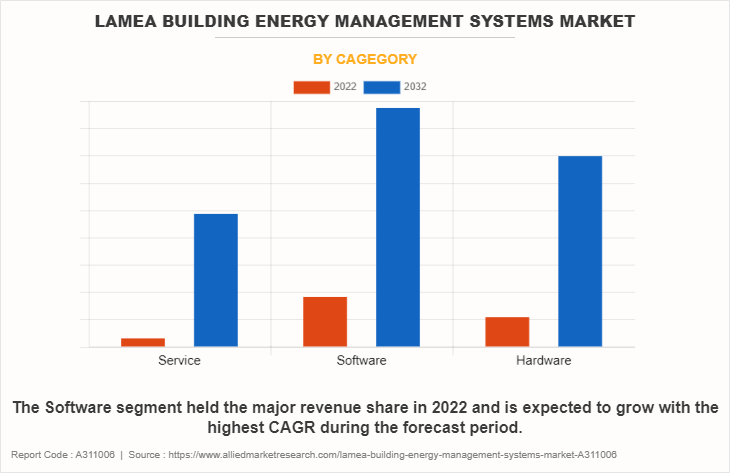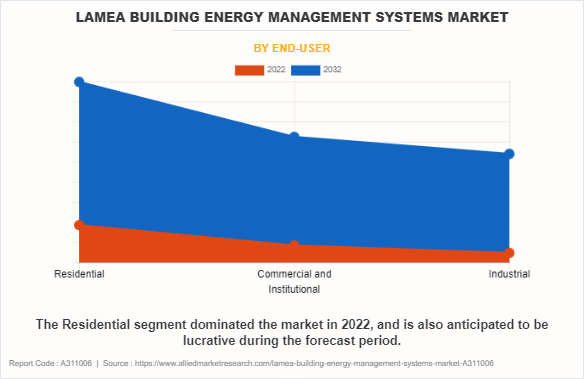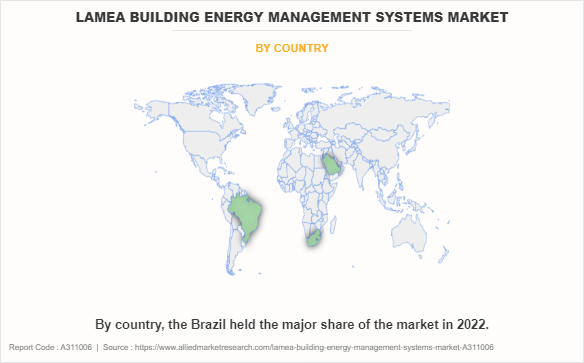The LAMEA Building Energy Management Systems Market is expected to register a CAGR of 11.3% during the forecast period.
Report Key Highlighters:
- The study integrated high-quality data, professional opinions and analysis, and critical independent perspectives. The research approach is intended to provide a balanced view of LAMEA building energy management system market and to assist stakeholders in making educated decisions in order to achieve their most ambitious growth objectives.
- Over 3,700 product literature, annual reports, industry statements, and other comparable materials from major industry participants were reviewed to gain a better understanding of the market.
- The LAMEA building energy management systems market share is highly fragmented, with several players including Schneider Electric, Johnson Controls, Schneider Electric South Africa, Ingersoll Rand, Rockwell Automation, Cylon Controls, Advantech Co., Ltd, Emerson Electric Co., Legrand, Blue Pillar, Inc. Also tracked key strategies such as acquisitions, product launches, mergers, expansion etc. of the players operating in the LAMEA building energy management systems market growth.

LAMEA building energy management systems industry is a comprehensive solution designed to monitor, control, and optimize energy consumption within buildings. Its primary goal is to enhance energy efficiency, reduce environmental impact, and streamline operational processes. In the Latin America, Middle East, and Africa (LAMEA) region, the adoption of BEMS is gaining momentum as organizations recognize the importance of sustainable practices and seek ways to cut costs associated with energy usage.
In various end-use industries across LAMEA, BEMS plays a pivotal role in transforming the way buildings manage their energy resources. One of the key applications of BEMS is in the commercial sector, where businesses aim to balance operational efficiency with environmental responsibility. By utilizing BEMS, companies can monitor and control heating, ventilation, and air conditioning (HVAC) systems, lighting, and other energy-consuming elements, resulting in significant energy savings and a reduced carbon footprint. This is particularly crucial in the context of rising energy costs and increasing awareness of climate change.
In the industrial sector, BEMS proves to be invaluable for optimizing energy-intensive processes. Manufacturers in the LAMEA region leverage BEMS to monitor and manage the energy consumption of machinery and production lines, thereby improving overall energy efficiency. This reduces operational costs and aligns with sustainability goals, positioning businesses as environmentally responsible entities.
The residential sector in LAMEA is also witnessing the integration of BEMS into smart homes. Homeowners are increasingly adopting BEMS to monitor and control heating, lighting, and other energy-consuming devices remotely. This not only enhances convenience but also contributes to energy savings, allowing residents to actively participate in the region's sustainability efforts.
The integration of advanced technologies, such as Internet of Things (IoT) devices and sensors, further enhances the capabilities of BEMS in LAMEA. These technologies enable real-time monitoring and data analysis, allowing for more precise control over energy consumption. Additionally, the data collected by BEMS can be used for predictive analytics, helping organizations anticipate energy needs and optimize their systems accordingly.
Implementation of smart sensors and control systems drives the growth of LAMEA building energy management system market.
Smart sensors can detect the presence of occupants in different areas of a building. By analyzing occupancy patterns, the BEMS can adjust lighting, heating, and cooling systems to match the actual usage, preventing unnecessary energy consumption in unoccupied spaces. Integration of weather sensors allows building energy management systems (BEMS) to consider external conditions when regulating indoor climate systems. For example, on a sunny day, the system might adjust shading devices to minimize solar heat gain, optimizing energy efficiency.
Smart control systems use adaptive algorithms that continuously learn and adapt to changing conditions. This enables the BEMS to fine-tune operations based on historical data and real-time feedback, ensuring optimal energy performance. BEMS with smart controls can participate in demand response programs. During peak energy demand periods, the system can automatically adjust energy consumption, contributing to grid stability and potentially earning incentives for the building owner.
In March 2022, Hitachi Elevator Co. Ltd, a joint venture of Hitachi Ltd and Siam Motors Group, introduced a comprehensive Smart Building Solution business in Thailand and Southeast Asia. The initiative, leveraging the Lumada IoT platform, focuses on enhancing building value through physical security systems and digital services, catering to the evolving needs of the new normal.
However, rise in cybersecurity concerns is expected to restraint the market. The escalating interconnectivity of components within Building Energy Management Systems (BEMS) introduces a significant restraint in the form of heightened cybersecurity vulnerabilities. As BEMS components become more interconnected, they become susceptible to a range of cybersecurity threats, presenting a formidable challenge in ensuring the robust security of these systems. This vulnerability exposes BEMS to potential breaches, unauthorized access, and data manipulation, thereby restraining the widespread adoption and implementation of BEMS solutions. Organizations and stakeholders must address these cybersecurity concerns proactively to mitigate risks and safeguard the integrity of BEMS infrastructure.
The LAMEA building energy management systems market is segmented into category, end-use industry, and region. On the basis of category, the market is classified into service, software, and hardware. On the basis of the end-use industry, the market is divided into residential, commercial & institutional, and industrial. In LAMEA the market is studied across Brazil, Saudi Arabia, South Africa, and the rest of LAMEA.

On the basis of category software segment dominated the LAMEA building energy management systems market in 2022. The integration of BEMS into software platforms enhances its functionality and usability. Software solutions facilitate user-friendly interfaces, data visualization, and remote access, allowing stakeholders to monitor and manage building energy performance efficiently. This integration is particularly crucial in large-scale commercial and industrial facilities where complex energy systems require sophisticated control mechanisms.

Based on end-use industry residential segment LAMEA dominated the building energy management systems market in 2022. Building Energy Management Systems are becoming increasingly indispensable in residential settings across the Asia Pacific region. As the demand for energy continues to rise, the implementation of BEMS offers a sustainable and efficient solution to address the challenges associated with energy consumption. With ongoing technological advancements, affordability, and supportive government policies, BEMS is poised to play a pivotal role in shaping the future of residential energy management in the Asia Pacific.

Brazil has been increasingly adopting building energy management systems (BEMS) to improve energy efficiency in various sectors. BEMS helps in monitoring, controlling, and optimizing energy consumption in buildings. The adoption of such systems is often driven by a combination of environmental concerns, energy cost savings, and regulatory initiatives.
The major players operating in the LAMEA building energy management market include Schneider Electric, Johnson Controls, Schneider Electric South Africa, Ingersoll Rand, Rockwell Automation, Cylon Controls, Advantech Co., Ltd, Emerson Electric Co., Legrand, Blue Pillar, Inc.
Key Benefits For Stakeholders
- The report provides a comprehensive analysis of the current market estimations through 2022-2032, which would enable the stakeholders to capitalize on prevailing market opportunities.
- Major countries are mapped according to their revenue contribution to the LAMEA building energy management systems market analysis.
- In-depth analysis of the LAMEA building energy management systems market forecast to assists to determine the prevailing market opportunities.
- Identify key players and their strategic moves in LAMEA building energy management systems market trends.
- Assess and rank the top factors that are expected to affect the growth of LAMEA building energy management systems market statistics.
- Analyze the market factors in various countries and understand business LAMEA building energy management systems market opportunities.
- Player positioning provides a clear understanding of the present position of key market players.
LAMEA Building Energy Management Systems Market Report Highlights
| Aspects | Details |
| Forecast period | 2022 - 2032 |
| Report Pages | 120 |
| By Cagegory |
|
| By End-User |
|
| By Country |
|
| Key Market Players | Oman Ministry of Oil and Gas, Egypt Ministry of Electricity and Renewable Energy, South Africa National Energy Regulator, Brazil Ministry of Mines and Energy, United Arab Emirates Ministry of Energy and Industry, Kuwait Ministry of Electricity and Water, Argentine Ministry of Energy and Mines, Saudi Arabia Ministry of Energy, Qatar General Electricity and Water Corporation, Colombia Ministry of Mines and Energy |
The LAMEA Building Energy Management Systems Market is projected to grow at a CAGR of 11.3% from 2022 to 2032
Saudi Arabia Ministry of Energy, Brazil Ministry of Mines and Energy, United Arab Emirates Ministry of Energy and Industry, South Africa National Energy Regulator, Oman Ministry of Oil and Gas, Kuwait Ministry of Electricity and Water, Egypt Ministry of Electricity and Renewable Energy, Qatar General Electricity and Water Corporation, Argentine Ministry of Energy and Mines, Colombia Ministry of Mines and Energy are the leading players in LAMEA Building Energy Management Systems Market
1. The report provides a comprehensive analysis of the current market estimations through 2022-2032, which would enable the stakeholders to capitalize on prevailing market opportunities.
2. Major countries are mapped according to their revenue contribution to the lamea building energy management systems market.
3. In-depth analysis of the lamea building energy management systems market segmentation assists to determine the prevailing market opportunities.
4. Identify key players and their strategic moves in lamea building energy management systems market.
5. Assess and rank the top factors that are expected to affect the growth of lamea building energy management systems market.
6. Analyze the market factors in various countries and understand business opportunities. 7. Player positioning provides a clear understanding of the present position of key market players.
LAMEA Building Energy Management Systems Market is classified as by cagegory, by end-user
Loading Table Of Content...
Loading Research Methodology...



